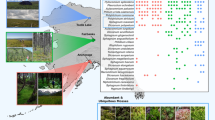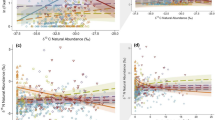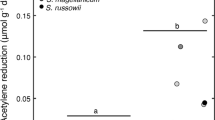Abstract
Moss-associated N2 fixation provides a substantial but heterogeneous input of new N to nutrient-limited ecosystems at high latitudes. In spite of the broad diversity of mosses found in boreal and Arctic ecosystems, the extent to which host moss identity drives variation in N2 fixation rates remains largely undetermined. We used 15N2 incubations to quantify the fixation rates associated with 34 moss species from 24 sites ranging from 60° to 68° N in Alaska, USA. Remarkably, all sampled moss genera fixed N2, including well-studied feather and peat mosses and genera such as Tomentypnum, Dicranum, and Polytrichum. The total moss-associated N2 fixation rates ranged from almost zero to 3.2 mg N m−2 d−1, with an average of 0.8 mg N m−2 d−1, based on abundance-weighted averages of all mosses summed for each site. Random forest models indicated that moss taxonomic family was a better predictor of rate variation across Alaska than any of the measured environmental factors, including site, pH, tree density, and mean annual precipitation and temperature. Consistent with this finding, mixed models showed that trends in N2 fixation rates among moss genera were consistent across biomes. We also found “hotspots” of high fixation rates in one-fourth of sampled sites. Our results demonstrated the importance of moss identity in influencing N2 fixation rates. This in turn indicates the potential utility of moss identity when making ecosystem N input predictions and exploring other sources of process rate variation.




Similar content being viewed by others
Data Availability
The data was published by the Arctic Data Center. The link to the publicly available dataset is https://arcticdata.io/catalog/view/doi:10.18739/A2QV3C475.
References
Ackermann K, Zackrisson O, Rousk J, Jones DL, DeLuca TH. 2012. N2 fixation in feather mosses is a sensitive indicator of N deposition in boreal forests. Ecosystems 15:986–98.
Aldous AR. 2002. Nitrogen translocation in Sphagnum mosses: effects of atmospheric nitrogen deposition. New Phytol 156:241–53.
Alexander V, Schell DM. 1973. Seasonal and spatial variation of nitrogen fixation in the barrow, Alaska, Tundra. Arct Alp Res 5:77–88.
Arróniz-Crespo M, Pérez-Ortega S, De Los Ríos A, Green TGA, Ochoa-Hueso R, Casermeiro MÁ, De La Cruz MT, Pintado A, Palacios D, Rozzi R, Tysklind N, Sancho LG. 2014. Bryophyte-cyanobacteria associations during primary succession in recently deglaciated areas of Tierra del Fuego (Chile). PLoS ONE 9:15–17.
Basilier K. 1979. Moss-associated nitrogen fixation in some mire and coniferous forest environments. Lindbergia 5:84–8.
Bates D, Maechler M, Bolker BM, Walker SC. 2015. Fitting linear mixed-effects models using lme4. J Stat Softw 67:1–48.
Bay G, Nahar N, Oubre M, Whitehouse MJ, Wardle DA, Zackrisson O, Nilsson MC, Rasmussen U. 2013. Boreal feather mosses secrete chemical signals to gain nitrogen. New Phytol 200:54–60.
Boike J, Kattenstroth B, Abramova K, Bornemann N, Chetverova A, Fedorova I, Fröb K, Grigoriev M, Grüber M, Kutzbach L, Langer M, Minke M, Muster S, Piel K, Pfeiffer EM, Stoof G, Westermann S, Wischnewski K, Wille C, Hubberten HW. 2013. Baseline characteristics of climate, permafrost and land cover from a new permafrost observatory in the Lena River Delta, Siberia (1998–2011). Biogeosciences 10:2105–28.
Bragina A, Berg C, Cardinale M, Shcherbakov A, Chebotar V, Berg G. 2012. Sphagnum mosses harbour highly specific bacterial diversity during their whole lifecycle. ISME J 6:802–13.
Brodribb TJ, Carriquí M, Delzon S, McAdam SAM, Holbrook NM. 2020. Advanced vascular function discovered in a widespread moss. Nature Plants 6:273–9.
Carrell AA, Kolton M, Glass JB, Pelletier DA, Warren MJ, Kostka JE, Iversen CM, Hanson PJ, Weston DJ. 2019. Experimental warming alters the community composition, diversity, and N2 fixation activity of peat moss (Sphagnum fallax) microbiomes. Global Change Biol 25:2993–3004.
Chapin FS. 2003. Effects of plant traits on ecosystem and regional processes: a conceptual framework for predicting the consequences of global change. Ann Bot 91:455–63.
Cornelissen JHC, Lang SI, Soudzilovskaia NA, During HJ. 2007. Comparative cryptogam ecology: a review of bryophyte and lichen traits that drive biogeochemistry. Ann Bot 99:987–1001.
Cutler DR, Edwards TC, Beard KH, Cutler A, Hess KT, Gibson J, Lawler JJ. 2007. Random forests for classification in ecology. Ecology 88:2783–92.
Darell P, Cronberg N. 2011. Bryophytes in black alder swamps in south Sweden: habitat classification, environmental factors and life-strategies. Lindbergia 34:9–29.
Deane-Coe KK, Mauritz M, Celis G, Salmon V, Crummer KG, Natali SM, Schuur EAG. 2015. Experimental warming alters productivity and isotopic signatures of tundra mosses. Ecosystems 18:1070–82.
DeLuca TH, Zackrisson O, Nilsson M-C, Sellstedt A. 2002. Quantifying nitrogen-fixation in feather moss carpets of boreal forests. Nature 419:917–20.
DeLuca TH, Zackrisson O, Gentili F, Sellstedt A, Nilsson MC. 2007. Ecosystem controls on nitrogen fixation in boreal feather moss communities. Oecologia 152:121–30.
Elumeeva TG, Soudzilovskaia NA, During HJ, Cornelissen JHC. 2011. The importance of colony structure versus shoot morphology for the water balance of 22 subarctic bryophyte species. J Veg Sci 22:152–64.
Eviner VT. 2004. Plant traits that influence ecosystem processes vary independently among species. Ecology 85:2215–29.
Fenton J. 1980. The rate of peat accumulation in antarctic moss banks. J Ecol 68:211–28.
Fox J, Weisberg S. 2011. An R companion to applied regression. 2nd edn. Thousand Oaks: Sage.
Gavazov KS, Soudzilovskaia NA, van Logtestijn RSP, Braster M, Cornelissen JHC. 2010. Isotopic analysis of cyanobacterial nitrogen fixation associated with subarctic lichen and bryophyte species. Plant Soil 333:507–17.
Gentili F, Nilsson MC, Zackrisson O, DeLuca TH, Sellstedt A. 2005. Physiological and molecular diversity of feather moss associative N2-fixing cyanobacteria. J Exp Bot 56:3121–7.
Genuer R, Poggi JM, Tuleau-Malot C. 2015. VSURF: an R package for variable selection using random forests. R J 7:19–33.
Gisnås K, Etzelmüller B, Lussana C, Hjort J, Sannel ABK, Isaksen K, Westermann S, Kuhry P, Christiansen HH, Frampton A, Åkerman J. 2017. Permafrost map for Norway, Sweden and Finland. Permafrost Periglac Process 28:359–78.
Goffinet B, Buck W. 2019. Classification of the bryophyta. On-line version available at http://bryology.uconn.edu/classification/. Checked on 01/13/2020.
Gornall JL, Jónsdóttir IS, Woodin SJ, Van Der Wal R. 2007. Arctic mosses govern below-ground environment and ecosystem processes. Oecologia 153:931–41.
Groffman PM, Butterbach-Bahl K, Fulweiler RW, Gold AJ, Morse JL, Stander EK, Tague C, Tonitto C, Vidon P. 2009. Challenges to incorporating spatially and temporally explicit phenomena (hotspots and hot moments) in denitrification models. Biogeochemistry 93:49–77.
Gundale MJ, Nilsson M, Bansal S, Jäderlund A. 2012. The interactive effects of temperature and light on biological nitrogen fixation in boreal forests. New Phytol 194:453–63.
Gundale MJ, Bach LH, Nordin AA. 2013. The impact of simulated chronic nitrogen deposition on the biomass and N2-fixation activity of two boreal feather moss-cyanobacteria associations. Biol Lett 9:20130797.
Hember RA. 2018. Spatially and temporally continuous estimates of annual total nitrogen deposition over North America, 1860–2013. Data Brief 17:134–40.
Hobbie SE. 1995. Direct and indirect effects of plant species on biogeochemical processes in Arctic ecosystems. In: Chapin FSI, Christian K, Eds. Arctic and alpine biodiversity: patterns, causes and ecosystem consequences. pp 213–24.
Hobbie SE, Gough L. 2002. Foliar and soil nutrients in tundra on glacial landscapes of contrasting ages in northern Alaska. Oecologia 131:453–62.
Hobbie SE, Gough L, Shaver GR. 2005. Species compositional differences on different-aged glacial landscapes drive contrasting responses of tundra to nutrient addition. J Ecol 93:770–82.
Holland-Moritz H, Stuart J, Lewis LR, Miller S, Mack MC, McDaniel SF, Fierer N. 2018. Novel bacterial lineages associated with boreal moss species. Environ Microbiol 20:2625–38.
Holland EA, Braswell BH, Sulzman J, Lamarque JF. 2005. Nitrogen deposition onto the United States and Western Europe: synthesis of observations and models. Ecol Appl 15:38–57.
Hugelius G, Strauss J, Zubrzycki S, Harden JW, Schuur EAG, Ping CL, Schirrmeister L, Grosse G, Michaelson GJ, Koven CD, O’Donnell JA, Elberling B, Mishra U, Camill P, Yu Z, Palmtag J, Kuhry P. 2014. Estimated stocks of circumpolar permafrost carbon with quantified uncertainty ranges and identified data gaps. Biogeosciences 11:6573–93.
Ininbergs K, Bay G, Rasmussen U, Wardle DA, Nilsson MC. 2011. Composition and diversity of nifH genes of nitrogen-fixing cyanobacteria associated with boreal forest feather mosses. New Phytol 192:507–17.
Jean M, Holland Moritz H, Melvin AM, Johnstone JF, Mack MC. 2020. Experimental assessment of tree canopy and leaf litter controls on the microbiome and nitrogen fixation rates of two boreal mosses. New Phytol (in press).
Jean M, Mack MC, Johnstone JF. 2018. Spatial and temporal variation in moss-associated dinitrogen fixation in coniferous- and deciduous-dominated Alaskan boreal forests. Plant Ecol 219:837–51.
Jonsson M, Kardol P, Gundale MJ, Bansal S, Nilsson MC, Metcalfe DB, Wardle DA. 2014. Direct and indirect drivers of moss community structure, function, and associated microfauna across a successional gradient. Ecosystems 18:154–69.
Kasischke ES, Johnstone JF. 2005. Variation in postfire organic layer thickness in a black spruce forest complex in interior Alaska and its effects on soil temperature and moisture 1. Can J For Res 35:2164–77.
Lebauer DS, Treseder KK. 2008. Nitrogen limitation of net primary productivity in terrestrial ecosystems is globally distributed. Ecology 89:371–9.
Lenth RV. 2016. Least-squares means: the R package lsmeans. J Stat Softw 69:1–33.
Leppänen SM, Salemaa M, Smolander A, Mäkipää R, Tiirola M. 2013. Nitrogen fixation and methanotrophy in forest mosses along a N deposition gradient. Environ Exp Bot 90:62–9.
Leppänen SM, Rissanen AJ, Tiirola M. 2015. Nitrogen fixation in Sphagnum mosses is affected by moss species and water table level. Plant Soil 389:185–96.
Lett S, Michelsen A. 2014. Seasonal variation in nitrogen fixation and effects of climate change in a subarctic heath. Plant Soil 379:193–204.
Liaw A, Wiener M. 2002. Classification and Regression by randomForest. R News 2/3.
Lindo Z, Nilsson MC, Gundale MJ. 2013. Bryophyte-cyanobacteria associations as regulators of the northern latitude carbon balance in response to global change. Glob Change Biol 19:2022–35.
Liu X, Wang Z, Li X, Rousk K, Bao W. 2019. High nitrogen resorption efficiency of forest mosses. Ann Bot:557–63.
Mills SE, Macdonald SE. 2004. Predictors of moss and liverwort species diversity of microsites in conifer-dominated boreal forest. J Veg Sci 15:189–98.
Minke M, Donner N, Karpov N, de Klerk P, Joosten H. 2009. Patterns in vegetation composition, surface height and thaw depth in polygon mires in the yakutian arctic (NE Siberia): a microtopographical characterization of the active layer. Permafrost Periglac Process 20:357–68.
Mitchell JS, Ruess RW. 2009. N2 fixing alder (Alnus viridis spp. fruticosa) effects on soil properties across a secondary successional chronosequence in interior Alaska. Biogeochemistry 95:215–29.
Oksanen J, Blanchet F, Friendly M, Kindt R, Legendre P, McGlinn D, Minchin PR, O’Hara R, Simpson GL, Solymos P, Stevens MHH, Szoecs E, Wagner H. 2019. vegan: Community ecology package. R package version 2.5–5.
Pastick NJ, Jorgenson MT, Wylie BK, Nield SJ, Johnson KD, Finley AO. 2015. Distribution of near-surface permafrost in Alaska: estimates of present and future conditions. Remote Sens Environ 168:301–15.
R Core Development Team. 2019. R: A language and environment for statistical computing. Vienna, Austria: R Foundation for Statistical Computing.
Reed SC, Cleveland CC, Townsend AR. 2011. Functional ecology of free-living nitrogen fixation: a contemporary perspective. Annu Rev Ecol Evol Syst 42:489–512.
Reed SC, Townsend AR, Cleveland CC, Nemergut DR. 2010. Microbial community shifts influence patterns in tropical forest nitrogen fixation. Oecologia 164:521–31.
Rixen C, Mulder CPH. 2005. Improved water retention links high species richness with increased productivity in arctic tundra moss communities. Oecologia 146:287–99.
Rousk K, Michelsen A. 2017. Ecosystem nitrogen fixation throughout the snow-free period in subarctic tundra: effects of willow and birch litter addition and warming. Glob Change Biol 23:1552–63.
Rousk K, Jones DL, DeLuca TH. 2013. Moss-cyanobacteria associations as biogenic sources of nitrogen in boreal forest ecosystems. Front Microbiol 4:1–10.
Rousk K, Sorensen PL, Lett S, Michelsen A. 2015. Across-habitat comparison of diazotroph activity in the subarctic. Microb Ecol 69:778–87.
Rousk K, Degboe J, Michelsen A, Bradley R, Bellenger JP. 2017. Molybdenum and phosphorus limitation of moss-associated nitrogen fixation in boreal ecosystems. New Phytol 214:97–107.
St. Martin P, Mallik AU. 2017. The status of non-vascular plants in trait-based ecosystem function studies. Perspect Plant Ecol Evol Syst 27:1–8.
Saiz E, Sgouridis F, Drijfhout FP, Ullah S. 2019. Biological nitrogen fixation in peatlands: comparison between acetylene reduction assay and 15N2 assimilation methods. Soil Biol Biochem 131:157–65.
Shaver GR, Jonasson S. 1999. Response of arctic ecosystems to climate change: results of long-term field experiments in Sweden and Alaska. Polar Res 18:245–52.
Simpson EH. 1949. Measurement of diversity. Nature 163:688.
Suzuki K, Kubota J, Yabuki H, Ohata T, Vuglinsky V. 2007. Moss beneath a leafless larch canopy: influence on water and energy balances in the southern mountainous taiga of eastern Siberia. Hydrol Process 21:1982–91.
Tarnocai C, Canadell JG, Schuur EAG, Kuhry P, Mazhitova G, Zimov S. 2009. Soil organic carbon pools in the northern circumpolar permafrost region. Global Biogeochem Cycles 23:1–11.
Turetsky MR, Mack MC, Hollingsworth TN, Harden JW. 2010. The role of mosses in ecosystem succession and function in Alaska’s boreal forest. Can J For Res 40:1237–64.
Turetsky MR, Bond-Lamberty B, Euskirchen E, Talbot J, Frolking S, McGuire AD, Tuittila ES. 2012. The resilience and functional role of moss in boreal and arctic ecosystems. New Phytol 196:49–67.
Vanderpoorten A, Shaw AJ, Goffinet B. 2001. Testing controversial alignments in amblystegium and related Genera (Amblystegiaceae : Bryopsida). Evidence from rDNA ITS sequences. Syst Bot 26:470–9.
Vanderpuye AW, Elvebakk A, Nilsen L, Archibald W. 2002. Plant communities along environmental gradients of high-arctic mires in Sassendalen, Svalbard. J Veg Sci 13:875–84.
Vile MA, Kelman Wieder R, Živković T, Scott KD, Vitt DH, Hartsock JA, Iosue CL, Quinn JC, Petix M, Fillingim HM, Popma JMA, Dynarski KA, Jackman TR, Albright CM, Wykoff DD. 2014. N2-fixation by methanotrophs sustains carbon and nitrogen accumulation in pristine peatlands. Biogeochemistry 121:317–28.
Walker DA, Jia GJ, Epstein HE, Raynolds MK, Chapin IS, Copass C, Hinzman LD, Knudson JA, Maier HA, Michaelson GJ, Nelson F, Ping CL, Romanovsky VE, Shiklomanov N. 2003. Vegetation-soil-thaw-depth relationships along a low-arctic bioclimate gradient, Alaska: synthesis of information from the ATLAS studies. Permafrost Periglac Process 14:103–23.
van Breemen N. 1995. How Sphagnum bogs down other plants. Trends Ecol Evol 10:270–5.
Van Wijk MT, Clemmensen KE, Shaver GR, Williams M, Callaghan TV, Chapin FS, Cornelissen JHC, Gough L, Hobbie SE, Jonasson S, Lee JA, Michelsen A, Press MC, Richardson SJ, Rueth H. 2004. Long-term ecosystem level experiments at Toolik Lake, Alaska, and at Abisko, Northern Sweden: generalizations and differences in ecosystem and plant type responses to global change. Glob Change Biol 10:105–23.
Wang T, Hamann A, Spittlehouse D, Carroll C. 2016. Locally downscaled and spatially customizable climate data for historical and future periods for North America. PLoS ONE 11:1–17.
Warshan D, Bay G, Nahar N, Wardle DA, Nilsson M-C, Rasmussen U. 2016. Seasonal variation in nifH abundance and expression of cyanobacterial communities associated with boreal feather mosses. ISME J 10:2198–208.
Warshan D, Espinoza JL, Stuart RK, Richter RA, Kim SY, Shapiro N, Woyke T, Kyrpides NC, Barry K, Singan V, Lindquist E, Ansong C, Purvine SO, Brewer HM, Weyman PD, Dupont CL, Rasmussen U. 2017. Feathermoss and epiphytic Nostoc cooperate differently: expanding the spectrum of plant-cyanobacteria symbiosis. ISME J 11:2821–33.
Weiss M, Hobbie SE, Gettel GM. 2005. Contrasting responses of nitrogen-fixation in arctic lichens to experimental and ambient nitrogen and phosphorus availability. Arct Antarct Alp Res 37:396–401.
Wullschleger SD, Breen AL, Iversen CM, Olson MS, Näsholm T, Ganeteg U, Wallenstein MD, Weston DJ. 2015. Genomics in a changing arctic: critical questions await the molecular ecologist. Mol Ecol 24:2301–9.
Yang Z, Gao J, Zhao L, Xu X, Ouyang H. 2013. Linking thaw depth with soil moisture and plant community composition: effects of permafrost degradation on alpine ecosystems on the Qinghai-Tibet Plateau. Plant Soil 367:687–700.
Zackrisson AO, Deluca TH, Nilsson M, Sellstedt A, Berglund LM, Zackrisson O. 2004. Nitrogen fixation increases with successional age in Boreal forests. Ecology 85:3327–34.
Zielke M, Solheim B, Spjelkavik S, Olsen RA. 2005. Nitrogen fixation in the high arctic: role of vegetation and environmental conditions. Arct Antarct Alp Res 37:372–8.
Acknowledgements
Funding was provided by the National Science Foundation Division of Environmental Biology Award 1542586. Further graduate student support was provided by the ARCS Scholarship Award and Northern Arizona University. Thanks to the Bonanza Creek LTER, Arctic LTER, and Toolik Field Station for their assistance and facilities. Additional thanks to Dakshina Marlier, Haley Dunleavy, Briana Jasinski, Henry Grover, Matthew Bowker, George Koch, and Ted Schuur for assistance with field work, coding, and comments.
Author information
Authors and Affiliations
Corresponding author
Additional information
Author Contributions
SFM, NF, JMP, and MCM conceived of the study, JEMS, HHM, LRL, MJ, SNM, SFD, NF, JMP, and MCM performed research, JEMS and MCM analyzed data, JEMS wrote the manuscript with HHM, MJ, SNM, SFM, NF, JMP, and MCM contributing to the manuscript.
Electronic Supplementary Material
Below is the link to the electronic supplementary material.
Rights and permissions
About this article
Cite this article
Stuart, J.E.M., Holland-Moritz, H., Lewis, L.R. et al. Host Identity as a Driver of Moss-Associated N2 Fixation Rates in Alaska. Ecosystems 24, 530–547 (2021). https://doi.org/10.1007/s10021-020-00534-3
Received:
Accepted:
Published:
Issue Date:
DOI: https://doi.org/10.1007/s10021-020-00534-3




